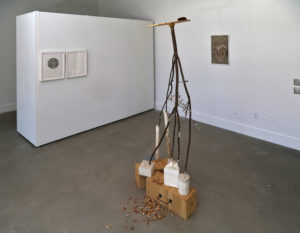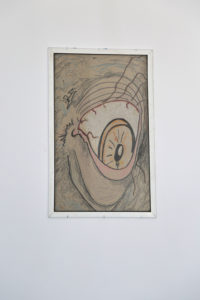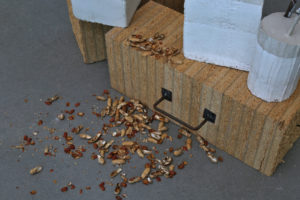
Photographs:George W Chevalier
Q & A with Kyle Lopinto
Gallery director Margaret Pezalla-Granlund interviewed Kyle Lopinto about his work in February, 2021. Lopinto’s work is included in the 2021 TCNJ faculty and staff exhibition, Envision Us.
Margaret Pezalla-Granlund: So I guess my first question is what can you tell me about your work and what’s going on with this piece that you put in the gallery?
Kyle Lopinto: It’s kind of like the kernel of the idea of what it ended up becoming was that kind of the relationship between that drawing of that eye, and then the sculptural part of it. From the get go, it was motivated by an anxiety around being scrutinized.
So, there’s the eye looking, but it’s supposed to be kind of like menacing but also kind of ridiculous. So it’s supposed to be both. Those feelings are meant to be present there. The sculptural piece ends up being something that was initially supposed to be something more obscuring but then it ended up being something more…t’s like almost figural, so it’s almost like you’re being scrutinized, but then you’re also the observer is kind of usually going to be kind of behind that seeing the eye and kind of maybe not probably not identifying with the sculptural part of it but like a little bit kind of feeling that it’s like a little bit of a barrier between you and the eye, but it’s also like a thing itself being scrutinized. And then, like around the sculptural part of it, there is a little bit of like…maybe like an anxiety, or like…maybe not frustration, but there’s someone like kind of anxiously killing time. I think that’s kind of what the peanut shells are there for. Those multiple, kinds of like, knife objects.
It’s like an expression of frustration, but it’s also like a little bit of like, kind of like a scratching of tally marks like kind of like a combining of time, is I think how I was thinking about it.
MP: It also seemed very much like a Saint Sebastian-like figure, being shot, with all the arrows. And the eye, I think like, felt very much like kind of a peering eye and had almost a surrealistic feel to it. So yeah definitely there’s that tension between the kind of figure and the eye on the wall.
KL: Yeah the eye is, um..my initial impulse was and- Not that an elephant is a significant creature, but I initially thought of in that way, it was like it was a gigantic I have a creature that you could or some kind of being that you couldn’t see the whole of. It was suggesting something very large, but it was also something that was like threatening but kind of unknown as well, like you, couldn’t tell what it was, but it was something that you wanted to not be observed by.
MP: Yea and I love that kind of 2D -> 3D relationship that is framed and it’s on the wall and it’s two-dimensional. But that also does feel very much like a window right?
KL: I had initially wanted it to be like that, the thing that is in front of the drawing is a window. I wanted a different window, but I couldn’t find one. I wanted it to look different. I wanted it to be more obviously a window, but I, you know, in the past you know, weeks and months I’ve been kind of like scrounging around. Kind of picking through trash to see if I could find a good window for it, I just didn’t find what I was looking for, unfortunately. But that is the only window, I could come up with that, I mean I guess theoretically could go like buy one but that’s not really. I don’t really like working that way so what it ended up being was that.
MP: Yeah I did want to ask you about your materials because you talked in your statement about wanting to work with found materials and wanting to find new uses for things and then wondering how that played out with this piece.
KL: Um yeah, so that method of I don’t really allow myself to buy things like certain things I will like if I need glue I can’t usually tend to find and a few other things, but in general I just don’t allow myself to consider buying things. I find…I’m not going to get too far into this, but I find the economic system that we all find ourselves under to be very constraining as it constrains just material things that you know we can’t often…Like getting the things that we (we as in, everyone) want or need. But it also constrains us in that it kind of demands things of our time and it demands things of our mind of like our ourselves, like the self that we can invest into things that our economic system demands so much out of…it’s like because it’s a limited thing you can only have you only have so much of yourself to give. And the more I can like kind of extricate… You know my self, my being, my life, my time, my thoughts from that process. It’s already so demanding. I feel like the better off I am for that and, like the more, it’s more satisfying, but it also feels less constrained it feels, I don’t know, I resent that mechanism so much that, the more I can kind of disengage from it, you know, the better, I feel.
MP: Do you have a studio where you live, do you work in your kitchen, you know, where do you make your work?
KL: For a few years, I had a studio outside- so like right after Grad school, I had a studio in our house like we have a two-bedroom house we’ve been renting and one of them was a studio for a while, then I moved it to the basement for a while and then I got a studio out of the house for a while, which was great. It’s so great to have a workspace. It’s so great to be able to set things up to leave things set up as you’re working on them, so you can go revisit them, you can have multiple things going at once. After Cole was born, I only kept my studio for maybe four or five more months, and then it just got to be too expensive, so I just moved everything back into my basement. So right now I don’t have a dedicated studio space, like, I have the basement that has all of my stuff in it, and I can get some work done down there but it’s not really great for work and usually, if I need to get something done, I have like you know I have like maybe…I guess like if you were to break down the fractions of it, I have maybe like a quarter of a
MP: *laughs* That’s pretty great, it’s very portable there.
KL: Yes.
MP: And it’s free right?
KL: There’s a little bit of an opportunity cost because, like I can lose track of things when it’s in my brain but you just gotta make do *laughs*



